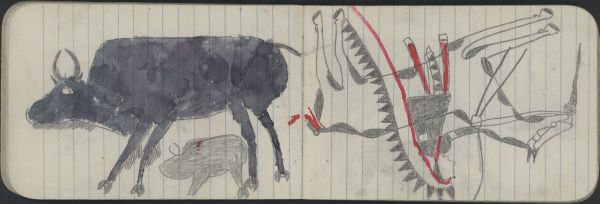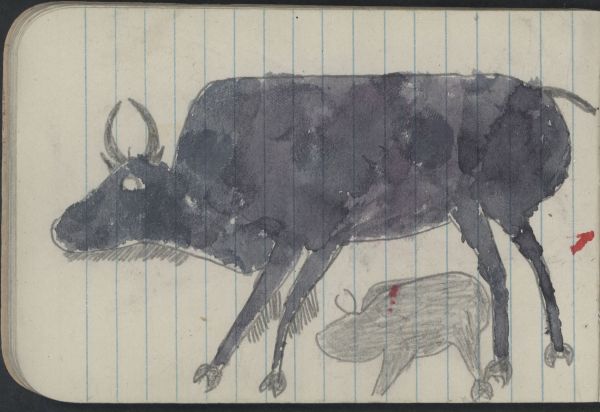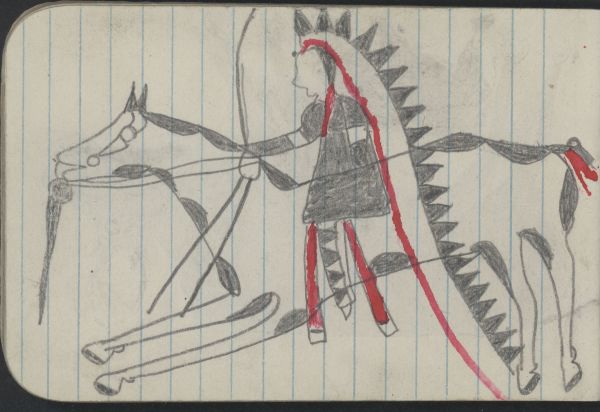ANIMALS, BUFFALO: Female Buffalo and Calf; WAR, WARRIOR: Man Wearing Headdress on White-and-gray Pinto Carries Saber
Ethnographic Notes
22 ANIMALS, BUFFALO. A large buffalo cow and calf are depicted moving from right to left across the page. The adult female's horns, split hooves, tail, and fringed beard and forelegs are detailed in pencil. The eye is an unpainted circle. The small calf is drawn between the cow's legs in pencil, and in this pose the calf does not have the movement suggested in PILA plate 12. This is one of many depictions of animal mothers and their young. This is one of eight nearly identical drawings in this ledger with a buffalo female and calf: Plates 11-18. For further discussion, see plate 11. This repetition of subject matter is unique in ledger art (Candace Greene, personal correspondence to Ramon Powers, 1985); one of the few other occurrences is in the Little Whirlwind Ledger, (Schoyen Collection, PILA plates 25, 27, 29), where a running stag is drawn three times with the same composition and style. 23 Warrior on pinto horse wears a single-trail full eagle bonnet, edged with red cloth, identical to the headdress elsewhere in the ledger (Plates 9, 10, 13-15, 17, 26-34, 36). He carries a saber, a common weapon on the Plains (Bonnie Kahn, "The Pamplin Ledger: Civilian, Indian, and Military Equipment," 2003: 97-9; Cowdrey, 1999: 18, Fig. 4- ca. 1867 photograph of Cloud Chief, Southern Cheyenne, with 1860 light-cavalry saber, from the Lessard Photo Collection).The arc shape of the saber may reflect moon imagery (see Imre Nagy, 2003: 227 regarding accretive moon-horn-claw motives). The saber was a weapon for combat as well as in use to count coup. The man wears a gray cloth shirt accented with nickel-silver armbands above the elbows. He wears a red clout, and his leggings are beaded with pattern of triangular ridges, what Peter J. Powell associates with the "Sacred Mountains" (1981: 564); this can simultaneously reference lightning: "The Cheyenne belief is that lightning shoots out from the eyes of the thunderbird, which seldom misses is target" (Cowdrey, 1999: 152); lightning bolts can represent "fleetness" and "the warrior's ability to strike the enemies swiftly and surely" (Gordon Yellowman, Sr., quoted by Craig Bates, 2003: 18). The warrior tied his horse's tail with red cloth--a decoration indicating preparation for military action. The scalp ornament at its mouth indicates the horse's involvement in war honors. It also indicates that this horse has, metaphorically, "eaten" the enemy (Cowdrey 1995:46). The horse wears a silver or German silver headstall (Kahn, 2003: 72, 81). See plates 9 and 10 for discussion of similar warrior images. Media: Lead pencil outlines, details, and fill; red watercolor details


